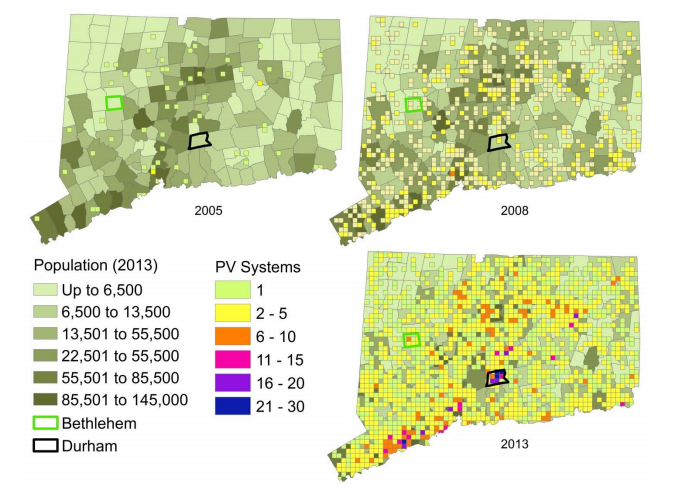Solar power growth in the U.S. appears to be contagious. Yes, contagious. If you install solar photovoltaic panels on your roof, that greatly increases the odds that your neighbours will, in turn, install their own panels.
That’s the upshot of a fascinating new paper in The Journal of Economic Geography looking at the growth of rooftop solar power across Connecticut. Rooftop solar took hold in a few initial spots back in 2005 — when the state first started offering solar subsidies. Rooftop systems then spread out from those clusters over time in a “wave-like centrifugal pattern”:
The growth of solar power in Connecticut, 2005-2013

Figure: Spacial pattern of adoption does not simply follow the population distribution
The researchers, Marcello Graziano of the University of Connecticut and Kenneth Gillingham of Yale, tried to figure out why solar power would expand in this way. Maybe solar power was just concentrating in large population centres. But this turned out not to be true — in fact, solar power was growing more rapidly in small- and medium-sized population areas.
Another possibility was that solar power was just proliferating in the rich parts of the state, among the households who could afford it. But that wasn’t true either. Households of all income levels are adopting solar power — there wasn’t a strong relationship between income and adoption rates.
After more careful examination, the researchers concluded that the evidence points in one direction — there are “neighbor effects.” Specifically, adding one rooftop system on a block increased the average number of installations within a half mile radius by 0.44. This builds on previous research finding similar effects in California.
Findings (abstract) from the study attempts to explain how this solar power contagion works
Basing on the hypothesis that the diffusion of new technologies is often mediated by spatial and socioeconomic factors, the authors examined the diffusion of residential solar photovoltaic (PV) systems using detailed data on PV installations in Connecticut.
They identified spatial patterns of diffusion, which indicate considerable clustering of adoptions that do not simply follow the spatial distribution of income or population.
They noticed that smaller centres contribute to adoption more than larger urban areas, in a wave-like centrifugal pattern, and their empirical estimation demonstrates a strong relationship between adoption and the number of nearby previously installed systems as well as built environment and policy variables.
They also found that the effect of nearby systems diminishes with distance and time, suggesting a spatial neighbour effect conveyed through social interaction and visibility.
To Conclude:
The authors concluded that these results disentangle the process of diffusion of PV systems and provide guidance to stakeholders in the solar market.
Solar analysts have suggested that this bodes well for the future of the technology. In a recent interview, Shayle Kann, senior vice president of GTM Research, said that one of the biggest costs for solar installers was simply finding new customers. Companies like SolarCity — which allow people to lease panels for no upfront cost and pay monthly fees — typically camp out at places like Home Depot.
But as solar power grows, word of mouth spreads, and referrals increase, those sign-up costs should come down. And, indeed, this reduction in “balance of systems” costs — all the costs of solar power that aren’t the panels themselves — is a big reason why the price of solar power keeps declining.
References:
Article: Adapted from the article Solar power is contagious: Installing panels often means your neighbors will too — written by Brad Plumer on October 24, 2014, for VOX.
Publication: Marcello Graziano and Kenneth Gillingham: Spatial patterns of solar photovoltaic system adoption: the influence of neighbors and the built environment, Oxford Journals — J Econ Geogr First published online: October 7, 2014.















Comments